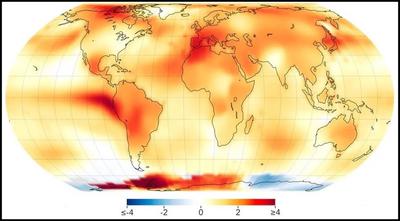This map shows how much warmer, in degrees Celsius, the Earth was in the summer of 2023 as compared to the average summer from 1951 to 1980. Lauren Dauphin / NASA Earth Observatory
The summer of 2023 was the hottest summer in the Northern Hemisphere since the height of the Roman Empire, a new study finds.
While scientists had already determined that last summer was the hottest on record, modern record-keeping only dates back to the 19th century. For the new study, researchers wanted to look back further into the past.
By analyzing tree rings, which keep a history of past temperatures, they found the summer of 2023 was the warmest in at least 2,000 years. With climate change and El Niño pushing heat to new extremes, last summer measured 2.20 degrees C (3.96 degrees F) warmer than the preindustrial average, and 3.93 degrees C (7.07 degrees F) warmer than the coldest summer seen in the past two millennia. The findings were published in the journal Nature.
“When you look at the long sweep of history, you can see just how dramatic recent global warming is,” said study coauthor Ulf Büntgen, of the University of Cambridge. “2023 was an exceptionally hot year, and this trend will continue unless we reduce greenhouse gas emissions dramatically.”
ALSO ON YALE E360
Nations Are Undercounting Emissions, Putting UN Goals at Risk



